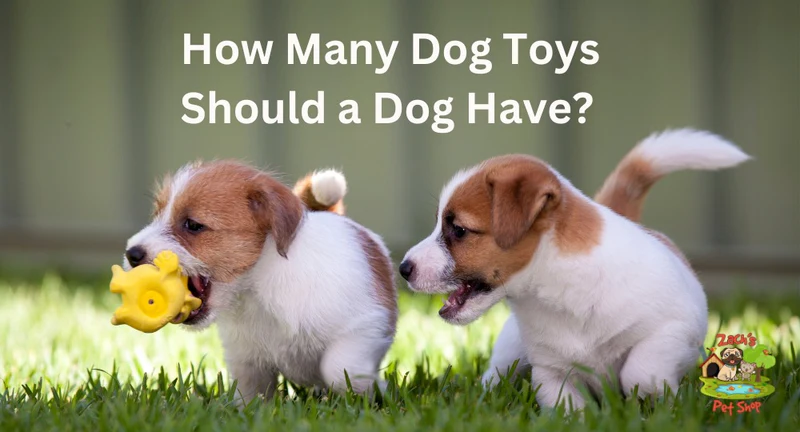When it comes to toys for our furry friends, the options seem endless! But have you ever wondered How Many Toys Should a Dog Have? It’s a question many pet owners ponder, and the answer might surprise you. Dogs, like humans, thrive on variety and stimulation. Having a selection of toys to choose from can enrich their lives in many ways. In this guide, we’ll explore the need for many toys for your dog. We’ll also cover how to choose the right ones. From chew toys to puzzles, each toy has a purpose. They keep your dog entertained, engaged, and mentally stimulated. Let’s dive into the world of dog toys.
How Many Toys Should a Dog Have?
Dogs can have many toys. The exact number depends on factors like your dog’s size, activity level, and personality. You may be interested in this also: Why Do Dogs Hide Their Treats
- Variety is Key: It’s good to have a variety of toys to keep your dog entertained and engaged. Different types of toys provide different kinds of stimulation.
- Start with a Few: When you first bring your dog home, start with a few toys to see which ones they like best. This can help you understand their preferences.
- Consider Your Dog’s Size: Larger dogs may need more durable toys, while smaller dogs may prefer toys they can easily carry and chew.
- Activity Level: Active dogs may benefit from more toys to keep them busy and prevent boredom. Puzzle toys and interactive toys can be especially stimulating for these dogs.
- Rotate Toys: Rotating your dog’s toys can keep them from getting bored with the same ones. You can put some toys away and bring them out later for a fresh experience.
- Quality Over Quantity: Invest in high-quality toys that are safe and durable. Cheaper toys may not last as long and could pose a choking hazard if they break apart.
- Supervise Playtime: Always watch your dog when they play with toys. This is especially true if they tend to chew and swallow parts of the toy.
- Replace Worn-Out Toys: Regularly check your dog’s toys for signs of wear and tear. Replace any toys that are damaged or falling apart to prevent choking hazards.
In general, having a few different types of toys for your dog to play with is a good idea. Pay attention to your dog’s preferences and adjust their toy collection accordingly. Remember, it’s not just about how many toys they have. It’s also about providing many stimulating activities. These keep them happy and healthy.
Tips for Rotating Dog Toys
- Create a Toy Rotation Schedule: Establish a schedule for rotating your dog’s toys. You can rotate them daily, weekly, or even monthly. The timing depends on your dog’s preferences and how many toys you have.
- Keep Some Toys Out of Reach: Store some toys out of your dog’s reach so they don’t have access to all their toys at once. This makes the toys you bring out later feel new and exciting.
- Observe Your Dog’s Preferences: Pay attention to which toys your dog enjoys the most and which ones they ignore. Rotate out the toys they’re less interested in and bring in new ones to keep things interesting.
- Introduce Toys Gradually: When you rotate in new toys, introduce them gradually to avoid overwhelming your dog. Start with one or two new toys at a time and see how your dog responds.
- Use Different Types of Toys: Rotate between different types of toys. These include plush, rubber, puzzle, and interactive toys. This provides variety and stimulates different senses and behaviors.
- Inspect Toys Regularly: Regularly inspect your dog’s toys for signs of wear and tear. Dispose of any toys that are damaged or have loose parts to prevent choking hazards.
- Engage in Interactive Play: Use rotating toys as an opportunity to engage in interactive play with your dog. Play games like fetch, tug-of-war, or hide-and-seek with their toys. This will bond with your pet and keep them sharp.
- Rotate Seasonally: Rotate toys seasonally to match your dog’s changing interests and energy levels. For example, in the summer, you might add water toys for outdoor play. In the winter, you could focus on indoor toys for mental play.
By following these tips, you can rotate your dog’s toys well. This will keep them entertained and engaged over time. Remember to watch your dog’s preferences. Adjust your schedule to fit them. This ensures they always have fun toys to play with.
FAQ’s
How many toys should a dog have at a time?
A few different toys is good.
Can my dog have too many toys?
Too many can be overwhelming.
Should dogs have toys all the time?
They can have toys when they want.
How often should I replace my dog’s toys?
When they’re worn out or broken.
Conclusion
In conclusion, the number of toys your dog should have depends on their likes, needs, and behaviors. There isn’t a one-size-fits-all answer. But, having many toys gives your dog options. They can use them for play, mental stimulation, and enrichment. Dogs need chew toys to satisfy their urge to gnaw. They need interactive toys to keep their minds sharp. They also need comfort toys for relaxation. Each type of toy serves a purpose in a dog’s life. By watching your dog’s reactions to different toys. Then, by rotating the toys, you can keep playtime exciting and engaging. Choose toys that are safe, durable, and suitable for your dog’s size and chewing habits. Quantity is not the goal, but quality.

